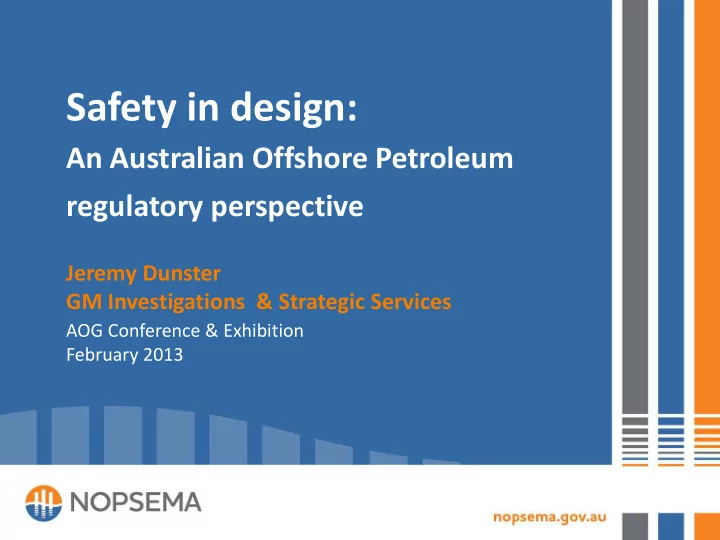

Safety in design: An Australian Offshore Petroleum regulatory perspective Jeremy Dunster GM Investigations & Strategic Services AOG Conference & Exhibition February 2013
Regulatory functions Monitor Compliance Investigate and Enforce Advise Improvement Promote Report Governance Co-operate A280510 February 2013 2
NOPSEMA’s coverage • Operations – Offshore petroleum operations – Offshore greenhouse gas storage operations • Scope – Occupational health and safety at facilities – Structural integrity of facilities and wells – Environmental management of petroleum activities A280510 February 2013 3
NOPSEMA’s jurisdiction NOPSEMA Relevant State/NT Minister or NOPSEMA where powers conferred A280510 February 2013 4
Legislation administered by NOPSEMA Commonwealth Offshore Petroleum and Greenhouse Gas Storage Act 2006 Schedule 3 – OHS law Safety Regulations Wells Regulations Environment Regulations Commonwealth Attorney-General’s website: comlaw.gov.au A280510 February 2013 5
Legal framework (OHS) • A ‘General Duties’ regime • Performance-based, but with prescriptive elements • An independent Regulator (NOPSEMA) • A facility operators safety case is used as a permissioning document, i.e. must be accepted in order to undertake activities. A280510 February 2013 6
Safety case life-cycle Agree Scope of Validation (SoV) Validation Statement A280510 February 2013 7
Validation Safety Case Decision-making Scope of Validation Validation Statement Agreed by NOPSEMA • Overview of facility/ Codes and standards • modification & process are appropriate Validation for Safety Critical If codes and standards • Element (SCE) selection are applied the facility • Codes & standards for will incorporate each SCE measures to protect • Validator selection Health & Safety process Consistency with • • Appropriateness of codes Formal Safety and standards Assessment • Deliverables A280510 February 2013 8
The Safety Case Safety Case Submission A280510 February 2013 9
Safety case contents Facility Formal Safety Safety Management Description Assessment Description System Description Activities and HAZID HAZID Scope (Activities) Operating Parameters General Description Comprehensive (the layout of the facility) and Integrated Machinery and Equipment Description of Procedural Controls including: Description of OHS Risk Management Technical Controls Risk Assessment Risk Assessment including: Maintenance Safety Measures Communication Emergencies (EERA, FERA) Emergencies (EERA, FERA) Emergencies Safety Measures Emergencies Identification of Control Measures Identification of Identification of Performance Standards (Necessary to reduce the Control Measures Control Measures level of risk to ALARP) Corrective & Implemented Monitor, Audit and Review Preventative action & Functional? Implementation and Improvement of the SMS Implemented & Functional? A280510 February 2013 10
Reasonable Practicability Risk Cost to avert A280510 February 2013 11
ALARP High Risk Construct, Install, Operate, Modify, Decommission Concept Design Low Risk A280510 February 2013 12
Early engagement Early Engagement A280510 February 2013 13
Timing Window of opportunity Concept Selected Concept Evaluation Conceptual FID Design FEED Detailed Field activities Design Overseas Construction Cost to change Field Construct & Install Production A280510 February 2013 14
Future directions • Design notification style scheme: – Focus on concept selection & design – Required for production facilities – Basis for ongoing dialog, transitioning into submission of a safety case A280510 February 2013 15
Industry leadership challenge • Shaping and supporting an organisational culture which embraces and values inherent safety to effectively manage risk, by: – Early application; – Minimising hazards at their source; – Designing out hazards in preference to designing in control measure complexity; – Ensuring systems fail safe when things go wrong. A280510 February 2013 16
NOPSEMA OHS web resources A280510 February 2013 17
Questions?
Recommend
More recommend